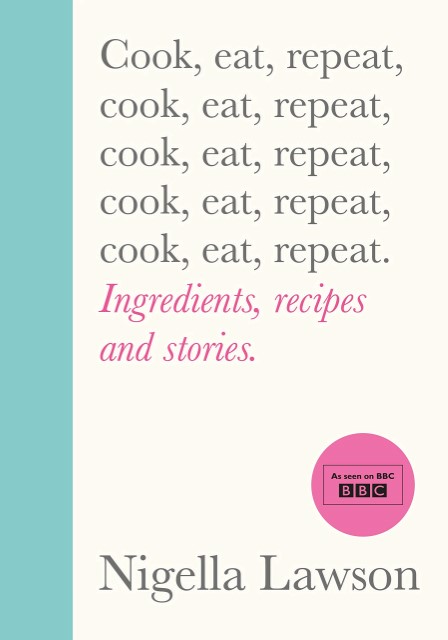Regular readers of this column will not be surprised to know that the Christmas list my family asked me to provide in December, contained several books. I was fortunate enough to receive them all: Barack Obama’s autobiography; poems by Michael Rosen about refugees; Patchwork, a fascinating memoir by a curator at the V&A; and the new book by Nigella Lawson: Cook, Eat, Repeat.

This last book, gave me much food for thought. (That was an unintentional pun but I think it works!) It is a lovely book to handle but it is actually quite tricky to find the recipes! This neither upset nor surprised me as the reviews that I had read all praised the prose, the narratives and the appealing writing style. There was no comment about ingredients or methods. In many ways this is now not uncommon and this thought sent me to my bookshelves in the kitchen on what turned out to be a reverie on social history.
The oldest cookery book I have was my mother’s and was published in 1951; Good Housekeeping’s Home Encyclopaedia. The foreword begins by saying: ‘To run a home happily and efficiently is probably the most rewarding of all jobs for a woman.’ Well, some may consider that to be so but I think in between the lines is some government propaganda saying that now the war is over we would like all women to get back into the kitchen please so that there are more jobs for the men. Before it gets onto the recipes, written in a very dense, concentrated style, Good Housekeeping offers advice on bleeding and poisoning, (the prevention thereof!) frost protection and fumigation. It details 14 possible ways to fold a napkin, an unbelievable 42 ways to use a forcing bag and the advice that your husband may enjoy an aperitif and some small appetiser when he comes home from work and before he is ready to sit down for his evening meal! The exclamation marks are of course my own.
My grandmother gave me an updated Good Housekeeping cook book for my 18th birthday. I can get quite nostalgic about this one. It contains the Christmas cake recipe that I used for 25 years until I had had enough, decided that few of my family liked fruit cake and so bought one from M&S instead. And there is the gingerbread recipe on very sugary and treacly stained pages that I cooked time and again, year after year for Church House teas. Interestingly well into the late 20th century, this book is still offering sets of weekly recipe plans that contain 3 cooked meals a day. I remember this from my childhood. Sandwiches were for Sunday afternoons and cricket club teas, rolls for picnics and days on the beach. There were certainly no packed lunches either for my father in his London office or for me at school. There was no obesity crisis at that time, indeed the word was not even in general usage, so I can only assume that portion sizes were much smaller, thus avoiding the problem. To give them their due, this 1960s/70s book does state: ‘Sugar, this is one carbohydrate that everyone should eat less of as it contains very few nutrients.’
And then there was Delia. Delia Smith, on television and in print always felt to me rather like a favourite aunt or godmother who had been landed with the job of teaching you to cook. Her approach was kind but firm and it was very clear that she was in charge. Looking at her books now, it strikes me that they are indeed full of imperatives; cut here, mix well, pour the juices. The fashion of late seems to be gentler and contains more conditionals: you might like to, if you want a thicker sauce, you could add etc, etc. What does this say about today I wonder? Maybe that we don’t want to be lectured or we would like to be offered choices and we want to make some of the decisions ourselves.
And so now we have books that might sit more comfortably on the coffee table rather than on the kitchen bookshelf. They are beautiful, produced on thick, creamy paper with vivid, full colour pages. And I think they are now almost more lifestyle books rather than recipe books that earlier generations might recognise. ‘Much More Veg’ by Hugh Fearnley-Whittingstall is an example. I don’t think I will try the tofu, mushrooms and seaweed but red pepper and chickpea soup is scrummy. He of course has an agenda here; he writes: ‘It is without doubt a very good idea to make vibrant, nutritious plant foods the basis of our diets.’ Mary Berry may not quite agree, she of the ‘Of course I will be using full fat milk/fromage frais/yoghurt etc.’ Bless her. My favourite book of hers is: ‘Family Sunday Lunches.’ Here she employs all her family, the dog and her lovely garden in Penn, to add to the comforting feeling of the family gathering. ‘Gather’ is the title of a recent book by Gill Mellor, another chef from the River Cottage establishment. Just like Nigella’s book, the reviews on his work talk of the poetry in his prose writing, never mind the recipes. The critic certainly didn’t.
And so back to ‘Cook, Eat, Repeat.’ Thinking about it, the title could give the impression of a Sisyphean task, suggesting repetition and drudgery. But, this is Nigella and this is what she says: ‘My initial interest in writing about food was a linguistic one: how could I use language to convey a realm that lay so far beyond it. A recipe has to take root in the reader’s imagination.’
You see what I mean? Happy cooking … or maybe just reading about it.
